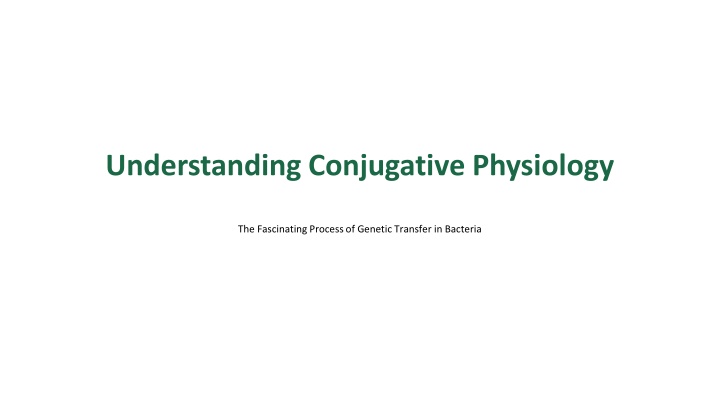
Conjugative Physiology: Understanding Genetic Transfer in Bacteria
Explore the fascinating process of conjugation in bacteria, where genetic material is transferred between cells, driving evolution and adaptation. Learn about the historical background, mechanism, and significance of conjugative physiology, with implications for biotechnology, medicine, and combating antibiotic resistance.
Download Presentation

Please find below an Image/Link to download the presentation.
The content on the website is provided AS IS for your information and personal use only. It may not be sold, licensed, or shared on other websites without obtaining consent from the author. If you encounter any issues during the download, it is possible that the publisher has removed the file from their server.
You are allowed to download the files provided on this website for personal or commercial use, subject to the condition that they are used lawfully. All files are the property of their respective owners.
The content on the website is provided AS IS for your information and personal use only. It may not be sold, licensed, or shared on other websites without obtaining consent from the author.
E N D
Presentation Transcript
Understanding Conjugative Physiology The Fascinating Process of Genetic Transfer in Bacteria
01 Introduction to Conjugation Table of Contents 02 Historical Background 03 Mechanism of Conjugation 04 Significance of Conjugation 05 Conclusion
1 Introduction to Conjugation Conjugation is the transfer of genetic material between bacterial cells of opposite mating types that are in physical contact with each other. This process allows for genetic diversity and adaptation in bacterial populations, contributing to their survival and evolution. The donor and recipient cells play crucial roles in the transfer of genetic material, facilitated by structures like pili. Understanding conjugation can help in fields like biotechnology, medicine, and microbiology, especially in combating antibiotic resistance. We will explore the discovery, mechanisms, and significance of conjugation in bacterial physiology.
2 Historical Background Joshua Lederberg and Edward Tatum discovered conjugation in 1946 throughexperiments with E. coli. They mixed two auxotrophic strains of E. coli, leading to the discovery of genetic transfer. This groundbreaking work laid the foundation for understanding genetic exchange in bacteria. In 1950, Davis provided evidence that direct cell contact is essential for genetic transfer. These discoveries have had lasting implications for the study of genetics and microbial behavior.
3 Mechanism of Conjugation A pilus forms to connect the donor and recipientcells, facilitating the transfer of genetic material. Single-strandedDNA is passed from the donor to the recipient cell, allowing both to become viable donors. Direct contact between cells is crucial for the successful transferof genetic material. Plasmids often carry the genes that are transferredduring conjugation, enhancing genetic diversity. Successful conjugation can lead to new traits in bacterial populations, such as antibiotic resistance.
4 Significance of Conjugation Conjugation contributes to genetic variation, which is essential for evolution and adaptation. Understanding conjugation helps in addressing the spread of antibiotic resistance among bacteria. Conjugation can be harnessed in genetic engineeringand synthetic biology. It plays a vital role in microbial communities and their interactions. Ongoing research aims to furtherunravel the complexities of conjugation and its implications.
5 Conclusion We explored the definition, discovery, mechanism, and significance of conjugation. Conjugation is a driving force behindbacterial evolution and adaptation. Understanding conjugation can lead to innovative solutions in healthcare and technology. Encourage further exploration and research in the field of microbial genetics. Thank the audience for their attention and invite questions.
